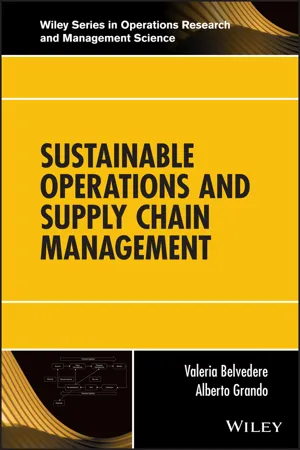
- English
- ePUB (mobile friendly)
- Available on iOS & Android
Sustainable Operations and Supply Chain Management
About this book
SUSTAINABLE OPERATIONS AND SUPPLY CHAIN MANAGEMENT
Sustainable Operations and Supply Chain Management addresses the most relevant topics of operations and supply chain management from the perspective of sustainability. The main focus is to provide a step-by-step guide for managerial decisions made along the product life cycle, following a path made up of the following steps: product design, sourcing, manufacturing, packaging and physical distribution, reverse logistics and recovery.
Guidance is provided on understanding traditional operations and supply chain management approaches, tools and techniques such as production planning, stock management, quality management and performance measurement, which can be adapted to achieve economic, environmental and social sustainability.
Key features:
- Repositions the main operations and supply chain management decisions developed in the perspective of the Life Cycle Analysis (Cradle-to-Cradle approach) and the Triple Bottom Line approach (economic, environmental and social sustainability)
- Covers sustainability and future trends, sustainable operations as a competitive factor as well as performance measurement and control
- Explores five main areas of operations and supply chain management; design for environment, procurement, manufacturing, packaging and distribution and reverse supply chain
- Provides a case study within each chapter to further the reader's understanding along with numerous examples and real-world problems
The book will be valuable for students at undergraduate and graduate levels in management and engineering schools, as well as for practitioners working in operations and supply chain management functions.
Frequently asked questions
- Essential is ideal for learners and professionals who enjoy exploring a wide range of subjects. Access the Essential Library with 800,000+ trusted titles and best-sellers across business, personal growth, and the humanities. Includes unlimited reading time and Standard Read Aloud voice.
- Complete: Perfect for advanced learners and researchers needing full, unrestricted access. Unlock 1.4M+ books across hundreds of subjects, including academic and specialized titles. The Complete Plan also includes advanced features like Premium Read Aloud and Research Assistant.
Please note we cannot support devices running on iOS 13 and Android 7 or earlier. Learn more about using the app.
Information
1
SUSTAINABILITY AND FUTURE TRENDS
1.1 INTRODUCTION
1.2 SUSTAINABILITY BEFORE SUSTAINABLE OPERATIONS AND SUPPLY CHAIN MANAGEMENT
- First, because, however much it may appear obvious, these are two factors that are essential for the survival of the planet, the scarcity and unfair distribution of which already require an urgent response today in terms of global policies that guarantee the access and the availability of them to an increasing number of people.
- Second, because these two elements, food and water, are intrinsically dependent on one another: to produce food, a large quantity of water is consumed, and therefore raising the quality and quantity of food offered to those who need it, given current technology and lifestyles, will lead to an rapid shortage of water resources.
- Third, because the solutions that may be advised today to deal effectively with these problems concern the productivity of the agro-food system, the technology required for increasing the aforesaid productivity, the fight against waste and the responsible management of the connected supply chains – the main topics of this work.
Table of contents
- COVER
- TITLE PAGE
- TABLE OF CONTENTS
- PREFACE
- ACKNOWLEDGEMENTS
- 1 SUSTAINABILITY AND FUTURE TRENDS
- 2 SUSTAINABLE OPERATIONS AND SUPPLY CHAIN MANAGEMENT AS COMPETITIVE FACTORS
- 3 SUSTAINABILITY AND NEW PRODUCT DESIGN
- 4 SUSTAINABILITY AND PROCUREMENT
- 5 SUSTAINABILITY AND PRODUCTION
- 6 SUSTAINABILITY AND LOGISTICS, PHYSICAL DISTRIBUTION AND PACKAGING
- 7 REVERSE LOGISTICS MANAGEMENT AND CLOSED-LOOP SUPPLY CHAIN
- 8 MEASURING SUSTAINABILITY
- REFERENCES
- INDEX
- OPERATIONS RESEARCH AND MANAGEMENT SCIENCE
- END USER LICENSE AGREEMENT